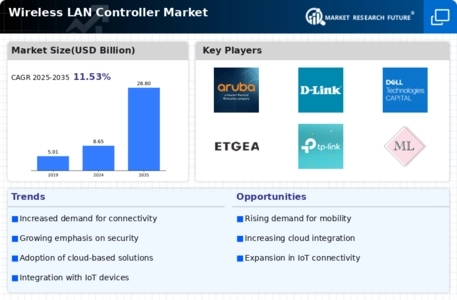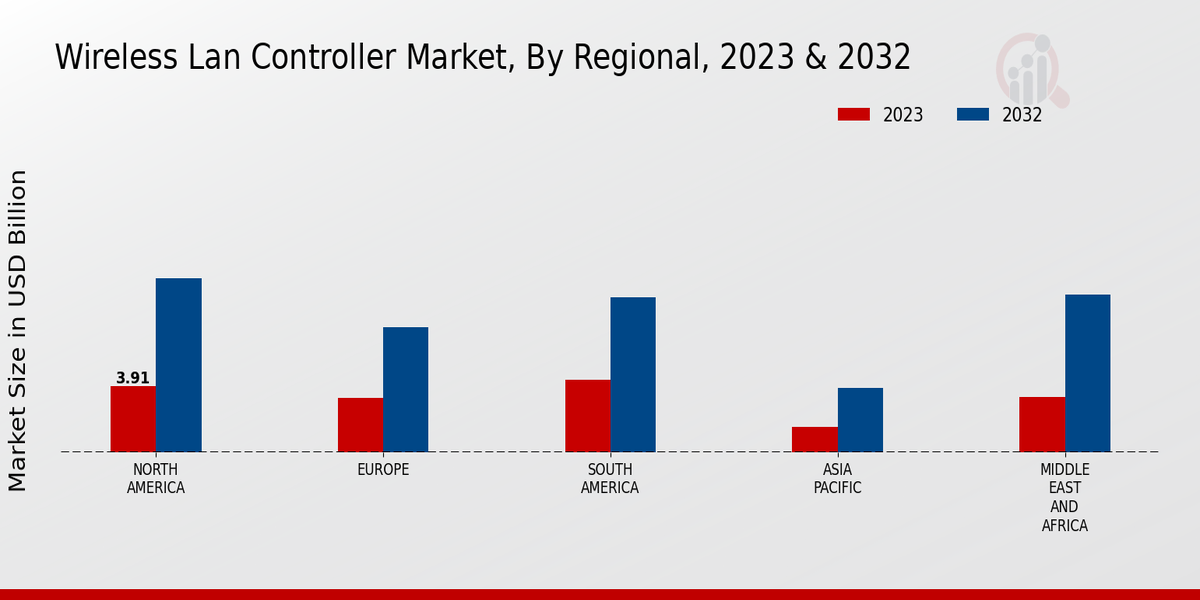Market Growth Projections
The Global Wireless LAN Controller Market Industry is on a trajectory of substantial growth, with projections indicating a market size of 8.65 USD Billion in 2024 and an anticipated rise to 28.8 USD Billion by 2035. This growth is underpinned by a compound annual growth rate of 11.54% from 2025 to 2035. Such figures illustrate the increasing reliance on wireless connectivity across various sectors, including education, healthcare, and enterprise environments. The demand for efficient network management solutions is likely to drive investments in wireless LAN controllers, reflecting the industry's adaptation to evolving technological landscapes.
Expansion of Smart Devices and IoT
The proliferation of smart devices and the Internet of Things (IoT) is a significant driver for the Global Wireless LAN Controller Market Industry. As more devices connect to wireless networks, the demand for effective management solutions becomes critical. This trend is particularly pronounced in smart homes and industrial applications, where multiple devices require stable and secure connections. The increasing number of connected devices is expected to contribute to the market's growth, with projections indicating a rise to 28.8 USD Billion by 2035. The integration of wireless LAN controllers in managing these devices enhances network performance and security, making them indispensable in modern connectivity solutions.
Increased Focus on Network Security
In the current landscape, the Global Wireless LAN Controller Market Industry is witnessing heightened attention towards network security. Organizations are increasingly aware of the vulnerabilities associated with wireless networks, prompting investments in advanced security measures. Wireless LAN controllers play a crucial role in safeguarding sensitive data and ensuring compliance with regulatory standards. As cyber threats evolve, the demand for secure wireless solutions is likely to escalate, driving market growth. This focus on security aligns with the projected compound annual growth rate of 11.54% from 2025 to 2035, as businesses prioritize the protection of their digital assets.
Growing Demand for High-Speed Connectivity
The Global Wireless LAN Controller Market Industry is experiencing a surge in demand for high-speed connectivity, driven by the increasing reliance on wireless networks for both personal and professional use. As organizations expand their digital infrastructure, the need for robust wireless solutions becomes paramount. In 2024, the market is projected to reach 8.65 USD Billion, reflecting a strong shift towards advanced wireless technologies. This trend is particularly evident in sectors such as education and healthcare, where seamless connectivity is essential for operational efficiency. The emphasis on high-speed internet access is likely to propel further investments in wireless LAN controllers.
Emergence of Advanced Wireless Technologies
The Global Wireless LAN Controller Market Industry is significantly impacted by the emergence of advanced wireless technologies such as Wi-Fi 6 and beyond. These technologies offer enhanced performance, increased capacity, and improved efficiency, catering to the growing demands of users. Organizations are increasingly adopting these innovations to optimize their wireless networks, leading to a surge in the deployment of wireless LAN controllers. The integration of these advanced technologies is likely to drive market growth, as businesses seek to leverage the benefits of higher data rates and reduced latency. This trend aligns with the overall expansion of the market, reflecting a shift towards more sophisticated wireless solutions.
Rise of Remote Work and Digital Transformation
The shift towards remote work and ongoing digital transformation initiatives are pivotal factors influencing the Global Wireless LAN Controller Market Industry. As organizations adapt to flexible work environments, the need for reliable wireless connectivity becomes increasingly critical. Wireless LAN controllers facilitate seamless access to corporate networks, enabling employees to work efficiently from various locations. This trend is expected to sustain market growth, with the industry poised for expansion as companies invest in infrastructure to support remote operations. The evolving work landscape underscores the importance of robust wireless solutions, further solidifying the role of wireless LAN controllers in modern business strategies.


 Source: Primary Research, Secondary Research, MRFR Database and Analyst Review
Source: Primary Research, Secondary Research, MRFR Database and Analyst Review






